Sensory experiences in humans and single-unit activity in cats evoked by polymodal stimulation of the cornea
- PMID: 11454968
- PMCID: PMC2278705
- DOI: 10.1111/j.1469-7793.2001.t01-1-00511.x
Sensory experiences in humans and single-unit activity in cats evoked by polymodal stimulation of the cornea
Abstract
1. The cornea of human subjects and of anaesthetised cats was stimulated with a jet of air of controlled flow, temperature and CO(2) concentration delivered by a gas aesthesiometer. 2. In humans, the intensity and magnitude of various components of the sensory experience (intensity of the sensation, degree of irritation, magnitude of burning and stinging pain, magnitude of the cold and warm components of the sensation) were measured using separate visual analog scales. In anaesthetised cats, the impulse response to the same stimuli was recorded from single mechanosensory, polymodal and cold-sensitive corneal fibres in the ciliary nerves. 3. Intensity-response curves for mechanical stimulation showed that all parameters of the sensation experienced by humans increased with the intensity of the stimulus. Mechanical stimuli recruited mainly phasic mechanosensory and polymodal afferents in the cat. 4. Acidic stimulation with gas mixtures of increasing CO(2) concentration evoked irritation, burning and to a lesser extent stinging pain of a magnitude roughly proportional to the intensity of the stimulus in humans. CO(2) primarily recruited polymodal afferents and weakly excited cold-sensitive fibres in the cat's cornea. 5. Heat stimuli evoked in humans a sensation profile similar to CO(2) but accompanied by a warmth component. In the cat's cornea, heat excited only polymodal fibres and silenced cold-sensitive corneal units. 6. Cold stimuli applied to the human cornea elicited a sensation of cooling that became irritant at the lowest temperatures. Corneal cold-sensitive fibres of the cat were activated in a manner proportional to the temperature drop, while polymodal nociceptor fibres were recruited only by the lowest temperatures. Topical menthol (0.2 mM) applied to humans evoked and later eliminated cold sensations produced by cold stimuli while the irritation sensation caused by low temperature stimuli still persisted. 7. Human subjects were able to identify masked mechanical, thermal and chemical stimuli applied to the cornea. 8. Irritation and cold sensations can therefore be evoked separately from the cornea by selective activation of mechanosensory, polymodal and cold corneal sensory afferents. Stimulation with different forms of energy usually leads to combined activation and/or inhibition of the different populations of sensory afferent fibres, evoking blended sensations that include irritation and thermal components in a variable degree.
Figures
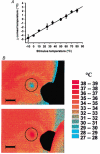
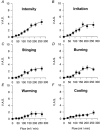
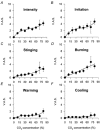

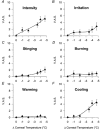
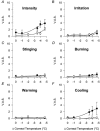

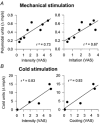
References
-
- Acosta MC, Gallar J, Belmonte C. Relationship between neural activity and sensations evoked by noxious stimulation of the cornea. Society for Neuroscience Abstracts. 1997;23:1257.
-
- Acosta MC, Gallar J, Belmonte C. The influence of eye solutions on blinking and ocular comfort at rest and during work at video display terminals. Experimental Eye Research. 1999;68:663–669. - PubMed
-
- Adriaensen H, Gybels J, Handwerker HO, Van Hees J. Suppression of C-fibre discharges upon repeated heat stimulation may explain characteristics of concomitant pain sensations. Brain Research. 1984;302:203–211. - PubMed
-
- Belmonte C, Acosta MC, Schmelz M, Gallar J. Measurement of corneal sensitivity to mechanical and chemical stimulation with a CO2 esthesiometer. Investigative Ophthalmology and Visual Science. 1999;40:513–519. - PubMed
Publication types
MeSH terms
Substances
LinkOut - more resources
Full Text Sources
Other Literature Sources
Medical
Miscellaneous

